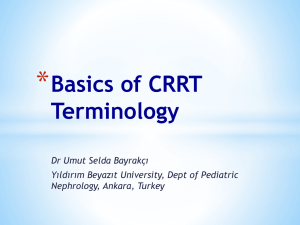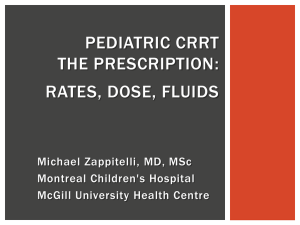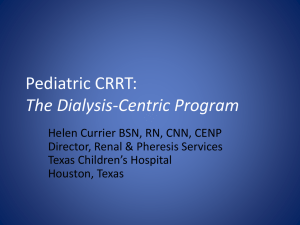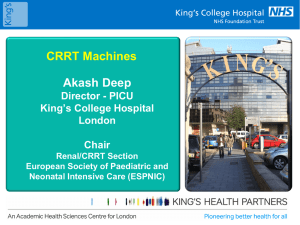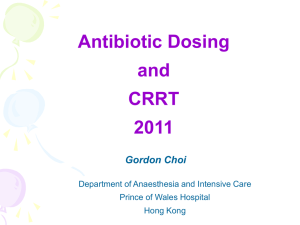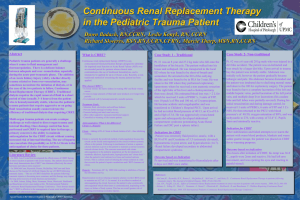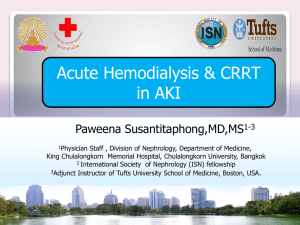Divisional Update: Women Mar 2008
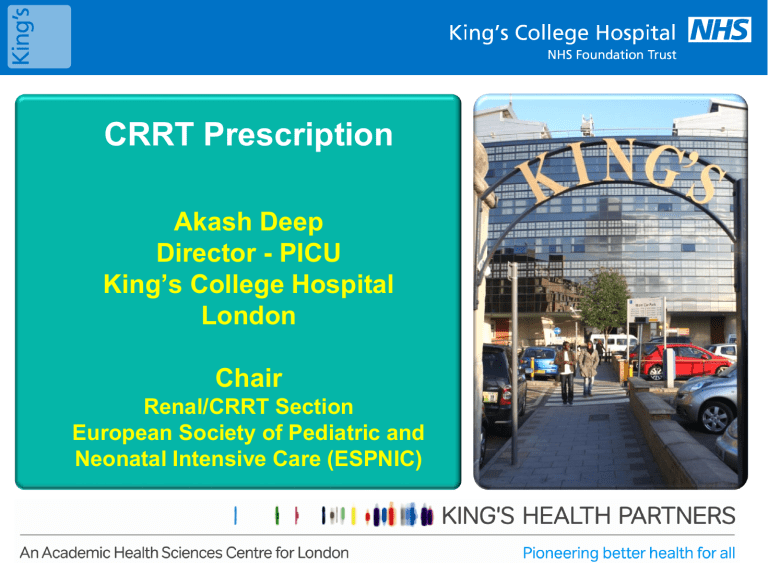
CRRT Prescription
Akash Deep
Director - PICU
King ’s College Hospital
London
Chair
Renal/CRRT Section
European Society of Pediatric and
Neonatal Intensive Care (ESPNIC)
0
Overview
Vascath
–
Size , location
Rates & Dose
Blood flow
Dialysis fluid
Replacement fluid
Ultrafiltration rate
Anticoagulation
Drug Dose
Suggested
Not necessarily a recipe
Is there a “typical” prescription?
• CRRT for AKI or Sepsis or Liver failure
– does the dose matter ?
• Modality : Do you do convective or diffusive or both , does it matter?
• Blood Flow rate: based upon the size of the child or what the vascular access can give you?
• Anticoagulation – Which, when, dose, mode of delivery
• Drug dosing – a perennial debate!!!!
Essential steps in CRRT Prescription
• Decide the Indication to start CRRT
• PRESCRIBE:
VASCULAR ACCESS – Size Location
Haemofilter and appropriate Sized Blood line set
Priming Solution
Blood Flow
Modality /Dose – Replacement Fluid/Dialysis Fluid
Prescribe Fluid loss rate
Prescription of electrolyte corrections
Anticoagulation – Dose,Modality, Monitoring
Drug Dosing
Blood flow rate
Qb
Age & weight
– based
Promote circuit lifespan + patient stability: clots vs alarms
Highly access-dependent
Aim return access pressures ~ < 200 mmHg, no alarms
Start lower and increase by about 10 minutes (?) – 50% of target and then go up 10% every 10 minutes till desired flow reached
Blood flow rate
No set “perfect rates”
From 3 to ~10 ml/kg/min, depending on age though we use minimum of 50 mls/min for newborns
Examples:
0-10 kg:
11-20kg:
21-50kg:
>50kg:
25-50ml/min
80-100ml/min
100-150ml/min
150-180ml/min
Based on previously most commonly used machine
Neonates 8 to 12 ml/kg/min
Children 4 to 8 ml/kg/min
Older 2 to 4 ml/kg/min.
Most not > 200 ml/min: not dangerous just not necessary
Blood flow rate
May need to modify:
- Patient hemodynamics – initial and subsequent
which might change with CRRT
- Be aware of access and return pressure
- Visually inspect filter for clots
- Trans-membrane pressure
– may need to increase blood flow
Treatment Dose
Dialysis and Replacement Fluid Rates:
Clearance & Dose
Clearance mostly a function of:
Dialysis fluid flow rate (Qd)
Replacement fluid flow rate (Qr)
Molecular weight and sieving coefficient
Qd + Qr (CVVHDF)
Higher rates
= higher clearance for IEM, drug removal, severe high K
= more middle molecule clearance (CVVH/CVVHDF)
= more hypophosphatemia, kalaemia, magnesaemia
= more amino acid losses
= more drug clearance
= more work to change bags, give electrolyte infusions
Dialysis and Replacement Fluid Rates:
Clearance & Dose
No well-defined right “dose” of clearance.
For CRRT: mostly expressed in terms of effluent (ml/kg) per hour
“Standard” suggestion:
Qd or Qr or Qd+Qr ~ 40-60 ml/kg/hour
Urea clearance
~ 30-40 ml/min/1.73msq
OR 2 to 2.5 liters/hr/1.73msq.
Some do much higher: some machines as high as 8L/hour
REALIZE:
What you prescribe is not necessarily what the patient gets!!
Time off circuit, microclots in filter over time, predilution
Prescribed and Delivered therapy dose
• Typically, therapy dose would be prescribed at 35 ml/kg/hr , in practice the delivered therapy dose was on average 8ml/kg/hr less .
• Prescription should exceed that calculated to be adequate because of the known gap.
• Why might we ‘ lose ’ significant amounts of therapy dose?
– Recirculation in vascular access
– High filtration fractions
– Filter clogging and clotting
– Troubleshooting skills
– Changing of circuits
– Filter down time
Vesconi et al Delivered dose of renal replacement therapy and mortality in critically ill patients with acute kidney injury Crit care 2009 13 (2);r57
CVVH
Qr = 300 ml/hour
CVVHDF
Qd = 150ml/hour
Qr = 150 ml/hour
CVVHD
Qd = 300 ml/hour
10 kg child: 30 ml/kg/hr “clearance”
OR ~ 0.26 msq: 2L/1.73msq/hour = 300 ml/hour
Dialysis Dose and Outcome
Ronco et al. Lancet 2000; 351: 26-30
425 patients
Endpoint = survival 15 days after D/C HF
146 UF rate 20ml/kg/hr survival significantly lower in this group compared to the others
139 UF rate 35ml/kg/hr p=0.0007
140 UF rate 45ml/kg/hr p=0.0013
Conclusions:
Minimum UF rates should be ~ 35 ml/kg/hr
Survivors had lower BUNs than non-survivors prior to commencement of hemofiltration
ATN Study
Randomised Evaluation of Normal vs Augmented
Level Replacement (RENAL) Therapy )
1500 critically ill adults
CVVHDF
25 ml/kg/hour
40 ml/kg/hour
Mortality at 28 days was similar in the higherintensity and lower-intensity treatment groups
(38.5% and 36.9%, respectively), and mortality at 90 days was the same (44.7%) in both groups.
Does the dose of solution exposure per unit of time matter
• These adult studies have failed to note a dose response curve of survival
• These studies are flawed for IHD vs CRRT was compared and CRRT was both convective and diffusive
So
• If you start with a standard prescription
• Eg
– BFR 5-10 mls/kg/min (access dependent)
– Membrane surface area proportional to patient body surface area
– Decision of convective or diffusive at approx
2000-3000/mls/hr/1.73m2
and
• If the marker of your clearance is not achieved
– E.g.
• inadequate clearance of Urea, Ammonia, intoxicant, lactate
• Then increase your solution exposure per unit of time
• Maximize convective clearance before adding diffusive clearance
• Consider increasing the BFR and increasing surface area of the membrane
• Filter downtimes to be minimised
Solutions
CVVHD – dialysis fluid for diffusive clearance
CVVH – replacement fluid:
replacing fluid you are removing to achieve solute clearance by convection
CVVHDF – both
Priming solutions – Saline /blood prime
Anticoagulant solutions
Using these to correct metabolic abnormalities (remove) and prevent treatment-related metabolic abnormalities (replace).
Dialysis fluid? Replacement fluid?
Personal suggestion: use the same solution
If needed (e.g. alkalosis) can modify the replacement solution
Regulatory issues may hinder:
Replacement solution – saline, with additives
Solutions: watch for errors!
Barletta et al, Pediatr Nephrol, 2006
Survey: ICU, Nephrology, CRRT
16/31 programs reported solution compounding errors with manually dispensed solutions
2 deaths
1 non lethal cardiac arrest
6 seizures (hypo/hypernatremia)
7 without complications
Ultrafiltration/fluid removal Rates
No Study has identified effective, safe UF rates in Children.
General acceptance that 1-2ml/kg/hr is often safe (stable patient)
Choose UF rate to:
- balance input (e.g. boluses, citrate, calcium, etc)
- remove excess fluid over time
“make room” for IV fluids and nutrition
- Also provides solute clearance by convection
Ultrafiltration/fluid removal Rates
Fluid removal should be safe AND effective – no need to sacrifice one for other:
–
Frequent communication
– Frequent reassessment (MD), Hourly reassessment
(RN)
Know what the
“usual hourly input is”:
» IV fluids
» Citrate & calcium
» Nutrition (give!!)
» Meds/infusions
» Provide “rules” for removing “intermittent fluids”
Be aware of the “outs” (tubes, urine, diarrhea)
Decide desired DAILY fluid removal based on:
Haemodynamics
TOTAL severity of Fluid Overload
SINGLE PASS Albumin dialysis -SPAD
Removes protein bound small substances:
e.g. copper/Wilson's, drugs, toxins of liver failure
Albumin live a scavenger
Dialysis :
albumin-containing solution across highly permeable membrane
20% albumin NOT “added” to dialysis fluid bag- it sinks however it is mixed with normal dialysate via 3 way tap -it's “single pass”
- bags are changed
Shouldn't affect sodium – may affect (reduce) other electrolytes
Collins et al, Pediatr Nephrol, 2008
Askenazi et al, Pediatrics, 2004
Ringe, Pediatr Crit Care Med, 2011
ANTICOAGULATION
ANTICOAGULATION-Points to consider
• Choice of anticoagulant
• Dose
• Route of delivery – systemic, into the circuit
• Heparin
• Citrate
• Prostacyclin
Anticoagulation
Dosing and Route
• Heparin – 10-20 U/kg/hour
• Prostacyclin – 2-8 ng/kg/min
• Citrate – separate protocol
• All anticoagulants to be used pre-filter with post filter monitoring ( ACT in heparin, ionised Ca in citrate)
Drug Dose Alteration
•
Drug dosing- important ( antibiotics, anticonvulsants, sedation, inotropes)
•
Hepatic failure + CRRT – Bigger issues
•
Based on:
– Protein Binding Information
–
Volume of Distribution
– Molecular Weight
Drug Prescribing in Renal Failure edited by George Aronoff et al
• Commonly carried text by pharmacists
• http://www.kdpbaptist.louisville.edu/renalbo ok/
• New edition to come out soon
• Recommendations for new drugs
• IHD and CRRT recommendations
• Pediatric recommendations
(T bunchman)
Summary
Blood flow: balance access/circuit life with tolerability
Solutions: Many choices
» Know their content, regional rules, CRRT type used
» Decide on desired flexibility
» Decide what's best for your institution (volume, expertise)
»
Bicarbonate and calcium are most substantial differences
» Be aware of errors – can be life threatening
Dialysis/replacement fluid rates: ie clearance dose
» Balance desired clearance with undesired losses
» 2-2.5 L/hour/1.73msq – suggested only
Ultrafiltration rate:
» Frequent reassessment, team + targeted fluid removal decisions
»
Safety AND efficacy are feasible
Acknowledgements
•
T Bunchman
•
pCRRT Foundation
•
